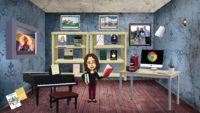
In spring of 2020 when schools closed their campuses due to a global pandemic, a common concern I heard from educators was lack of student engagement in virtual learning. Video call attendance was sparse, office hours were quiet, and virtual assignments were not viewed. Educators struggled to connect with students, to maintain relationships. Many schools will once again be designing learning experiences for students from a distance, on virtual platforms. How might we motivate students to participate in and take ownership of their learning? And how might we start the year strong, with a solid foundation that we can build upon?

The Universal Design for Learning (UDL) framework provides guidelines based on neuroscience, designed to increase accessibility to learning for our students. The goal of the principle “multiple means of engagement” is to foster expert learners who are purposeful and motivated. As the school year begins, virtual spaces can be used in a classroom or at a distance, to activate the affective networks of the brain.
Engaging Strategies to Build Community: Numerous studies refer to the positive impact of the teacher to student relationship in affecting academic achievement, attendance, engagement, and more. It is vital that educators begin the process. As a classroom teacher, I would begin the school year by sharing some of my interests with students. This would often spark conversations and lead to students sharing about themselves – perhaps they too enjoyed playing fetch with their dog and/or liked to read. Social emotional learning is vital during times of stress. During this time of global uncertainty, opportunities for students to connect with caring adults, and with peers is vital.
At a professional learning session I co-facilitated today, my colleague and I modeled a new way of building connections with the learners in our midst – virtual spaces with choice about what to explore. As participants explored our slides (each had hyperlinks to books, movies, television shows, recipes, and/or locations of interest), many asked further questions and shared about themselves in the chat. A participant remarked, “Katherine do you like to travel?” I answered in the affirmative and asked if she did as well. “Yes, I have visited multiple continents!” she remarked. When we share a bit of ourselves and express interest in others, we foster collaboration and community (UDL 8.3). The virtual space with clickable links also provides participants with individual choice and autonomy as they explore (UDL 7.1). You can create a virtual classroom in Google Slides or Powerpoint. Click on an image and add a website address for students to explore. If you save the slide as a PDF, the links will be clickable.
In order to encourage engagement in a shared virtual space, consider a collaborative platform for students to add what they notice and wonder about your virtual office/classroom. Jamboard is a simple to use tool, 100% free, that works well for this purpose.

It is important that students feel safe in speaking with an educator without fear of judgment from peers. Office hours may be intimidating for students who wish to ask for clarification on an assignment individually. Or perhaps a student has a question but is unavailable during your office hours time span. Presence builds relationships, availability and psychological safety foster increased positive interactions. Flipgrid is a 100% free platform that allows for two way communication in an asynchronous format, to allow students to contact you on their own time. At your convenience, you can view the video and respond with a video of your own. As a teacher, create a topic that is set to keep student responses private from peers, and share the link to this topic on a shared space such as Google Classroom.
Relationships with and amongst students is vital to the learning process. Be sure to be intentional about fostering community in virtual spaces.

